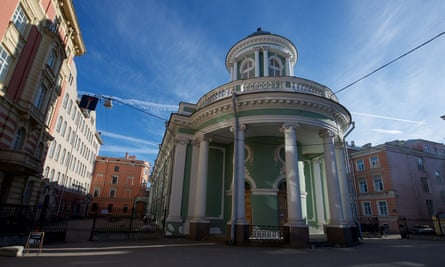Downtown Saint Petersburg is street after street of extravagant mansions, tenement buildings and palaces built at the height of the Russian empire. Not all have managed to maintain their splendour since that golden era, however – though you might say there’s something romantic about the gentle sense of decay.
If St Petersburg’s history as Russia’s cultural capital is etched out in its architecture, over time, many of those etchings have become faded: its mansions and palaces have been turned into hotels or condominiums; others have fallen into disuse and disrepair. Approximately 15,000 buildings date to before 1914 and most of them badly need renovation.
The state hasn’t been the one to answer that call.
“It happened at the time when Dmitry Medvedev was president – the economy and quality of life were growing,” says Alexander Basalygin, founder of the BS Art Development. There was a growing demand, he said, “for a new life of aesthetics – and public spaces in particular”.
Two years ago his group, a collective of artists, rented one of St Petersburg’s crumbling mansions – and they weren’t the only ones to do so. Between 2013 and 2016, around 20 new art-oriented spaces opened in St Petersburg each year, from galleries and private museums to co-working spaces. Now there are upwards of 200 creative spaces in the city, located in everything from former palaces to old Soviet warehouses. Collectively, St Petersburg’s artists have taken it upon themselves to save its historic buildings, one at a time.
The mansion adopted by Basalygin’s group is an 18th-century manor on the Fontanka river that was once home to the Golitsyns, a family of Russian nobles. For years it had been abandoned and decayed, despite being the meeting point of the well-known Arzamas literary society in the 19th century. The BS group renovated the building, subdivided it, added facilities and renamed it the Golitsyn Loft.

“Four years ago I had a dream about this place. When we came to inspect it, I realised that my dream came true,” says Oksana Kazakova, who runs the ID39 beauty space, one of the new tenants. “We saved the plasterwork, chimney, antique doors as best we could – though we had to sell our car to finish it.”
At 7,000 sq m, Golitsyn Loft’s five buildings form the largest creative space in the city. It has become a thriving hub of creativity, filled with designer showrooms, bars, architectural studios, barber shops, tattoo studios and poetry workshops.
Just 10 minutes from Golitsyn is a three-storey building on Bolshaya Konushennaya street, built in the art nouveau style. Its intricately carved ceilings were falling apart in 2015 when Tsarchitektor, a youth-oriented arts group, moved in. The building now holds bars, secondhand shops, and pottery and jewellery workshops. Nearby is Palma, another multi-use building with architect and design studios and rehearsal rooms, formerly home to German craftsmen in the 18th and 19th centuries and a mass of cheap dormitories, a gym, a chess club and a ballroom that lay ruined after the second world war.

While the Palma was bought by private investors, many of the renovations have been paid for through public fundraisers.
After a fire in 2002 destroyed much of the Annenkirche, an 18th-century Lutheran church on the Neva River, the building was abandoned to trees and rot. But in 2014 a group of young artists held an exhibition in its crumbling interior, and wanted to do more.
The money to bring the building up to basic standards is cobbled together from theatrical performances and concerts. “All together we need 400-500m rubles (£5-6m), and 80% of [concert] fees we put towards the renovation project cash fund,” says the Annenkirche’s abbot, Evgeny Raskatov. “The rest of money we channel to maintain the building and make minor repairs. Unfortunately, the Lutheran church cannot assist us in that endeavour.”
These artistic clusters come and go, giving a sense of transience to this aspect of St Petersburg’s urban life. According to ITMO University, the average lifespan of artists’ spaces is just four years, due to the inevitable price hikes in property values when “building owners decide that they can take better advantage than an artistic space”, says Alexandra Nenko, a researcher at ITMO.
Nevertheless, the artists are doing more than most, including the government, to keep the city’s historic buildings alive.
“Ideas and the creation of cultural products continue to grow in importance,” Nenko says. “Creative industries need their own place ... I am sure that they will continue to absorb abandoned mansions and palaces of St Petersburg.”
Follow Guardian Cities on Twitter, Facebook and Instagram to join the discussion, and explore our archive here

Comments (…)
Sign in or create your Guardian account to join the discussion